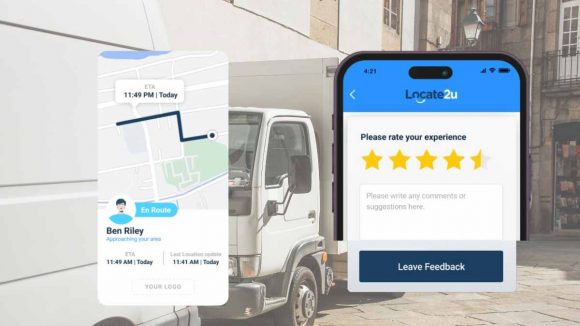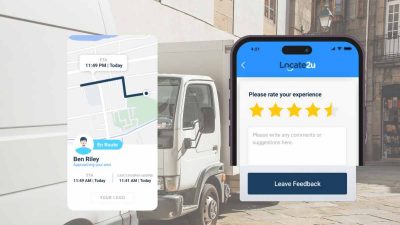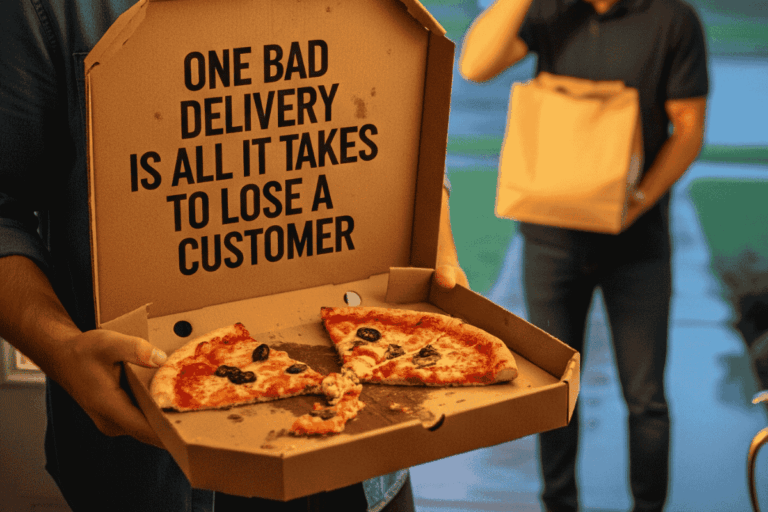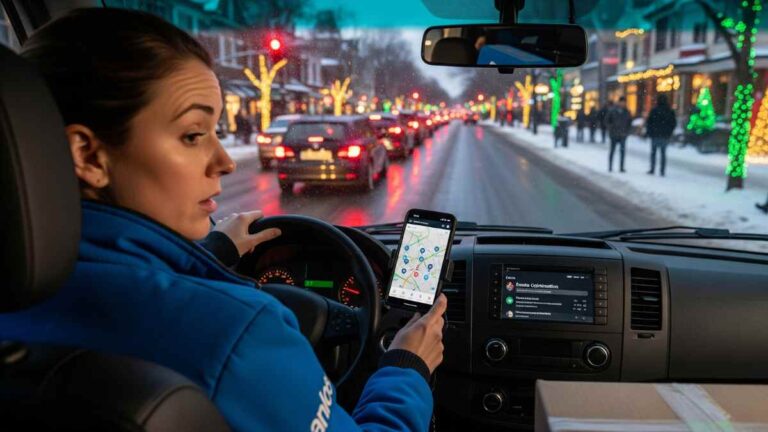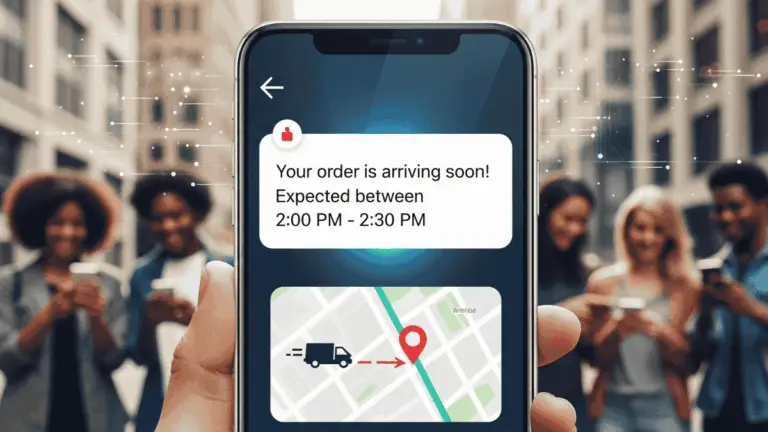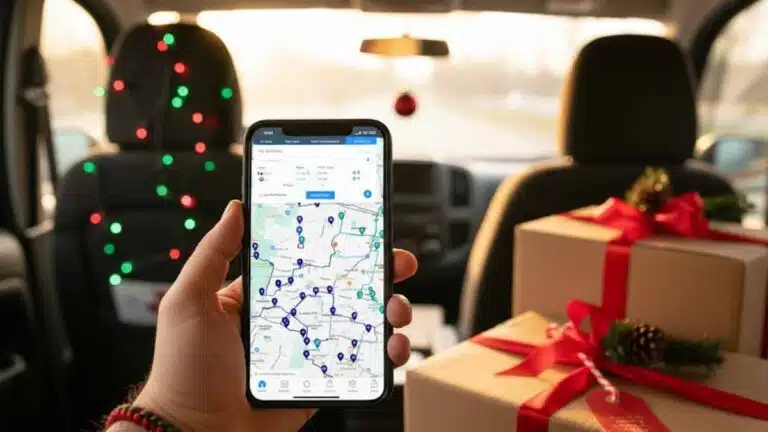Last-mile delivery is costly, and driver ratings matter.
Managing drivers, customers, and costs gets tricky when your fleet is behind. But merging communication, driver ratings, and technology can change that.
The future of e-commerce is blended with technology that takes the edge off logistics managers, drivers, and the possibility of making human errors.
A few elements are essential for successful customer satisfaction and fast last-mile deliveries.
According to Locate2u CEO Steve Orenstein, the secret lies in these elements:
- Communication
- Problem-solving (through customer feedback)
- Speed
With better last-mile delivery technology like route optimization, speed comes naturally.
There are driver apps that facilitate a live and real-time platform for better communication between customers, managers, and drivers.
Lastly, problem-solving can only take place once you know how your customers feel about your service, and that’s through feedback. Feedback is vital.
Feedback in the form of driver ratings gives customers the power to make their voices heard and provides the business with time to respond and correct mistakes.
This article will discuss these three elements and why they’re essential for your business.
What Are Driver Ratings?
Driver ratings help you track and evaluate whether your drivers are performing well or idling, sitting around all day, and not being productive.
There are various metrics this is based on. It’s not just on-time deliveries. It’s also safe driving habits, customer feedback, and checking if they are overall efficient.
It’s more than just scoring the driver; it’s about identifying a pattern and addressing a problem if necessary. It’s also about rewarding great performance.
For example, a driver who consistently gets positive feedback and avoids harsh braking or speeding should be recognized and incentivized.
Conversely, a driver who frequently misses deliveries or gets complaints needs coaching before customer relationships suffer.
@steve_orenstein The majority of businesses aren't getting this right… 👀 #SmallBusiness #Delivery #Entrepreneur #LastMileDelivery ♬ original sound – Steve Orenstein 🚚
What is Last-Mile Delivery?
Last-mile delivery is the final leg of the delivery journey and yet the most expensive part. It’s when goods go from the distribution hub to the customer’s doorstep.
It’s also the most challenging and transparent process. Customers expect fast, accurate deliveries, and any delays or miscommunication can frustrate them.
But if done right, with great technology like route optimization and real-time tracking, your deliveries can become super fast service.
The better your last-mile tech, the smoother the entire process.
ALSO READ: Why is last-mile delivery so expensive?
Why is Communication So Important in Delivery?
Communication isn’t just about giving drivers instructions; it’s about keeping everyone on the same page. You want your drivers, dispatchers, and customers in the loop and avoid confusion and a flood of calls back and forth.
Poor communication leads to missed deliveries, frustrated customers, and wasted resources. Delivery companies often implement strict penalties for missed deliveries, which can put customers off. However, using the right software can eliminate all of this.
Think about it. If a driver gets stuck in traffic but cannot inform the customer or dispatcher, that delay spirals into more significant issues. However, real-time tracking lets a customer see precisely when the ETA will be, and it’s constantly updated in case of bad weather or traffic.
Real-time tracking automates adjustments instantly, keeping deliveries on track and customers happy.
ALSO READ: 7 reasons why you need better communication during delivery of parcels
What Happens When Companies Ignore Communication and Driver Ratings?
Companies that don’t invest in communication and driver performance tracking often find themselves dealing with:
- Missed deliveries and inefficiencies
- Unhappy customers who leave bad reviews
- Higher fuel costs due to inefficient routes
- Increased driver turnover due to lack of feedback or incentives
E-commerce business owners often fall behind because they believe they have too small a fleet to implement route optimizations. But that’s not true. Even if you have one vehicle, saving on fuel and time still makes sense.
Future Trends in Merging Communication, Driver Ratings, and Last-Mile Tech
So, where is this all heading? The next wave of innovation will bring these elements closer together, making fleet management more intuitive and effective.
Here are three trends in how the three elements will merge to create the fastest, most efficient, and most satisfying delivery experience each time.
1. Smarter, Automated Communication
AI-driven chatbots, automated alerts, and predictive analytics will make communication between managers, drivers, and customers more effective.
Instead of manual check-ins, drivers will receive automatic updates, and customers will be kept informed without needing to call in.
2. Integrated Driver Ratings with Real-Time Data
Future systems will combine ratings with real-time GPS data, traffic conditions, and delivery success rates rather than examine driver performance in isolation.
This means managers can instantly spot trends and take action without manipulating spreadsheets.
3. AI-Powered Last-Mile Delivery Tech
Expect more automation in route optimization, with AI making adjustments on the fly based on traffic, weather, and delivery urgency.
Smart lockers and drone deliveries may also become more common, reducing strain on drivers and improving efficiency.
The Power of Combining All Three
When communication, driver ratings, and last-mile technology work together, everything just flows.
Drivers perform better because they are guided by real-time data and feedback. Customers get accurate ETAs and feel more in control of their deliveries.
As a fleet manager, you can see clearly what’s working and what needs improvement without the headache.
Companies that embrace this approach will see the following:
- Faster, more reliable deliveries
- Better driver performance and retention
- Fewer customer complaints
- Lower operational costs
Why Should You Invest in These Technologies?
Adopting these tools will help you run your fleet efficiently. The logistics world is evolving, and those who adapt will see faster results while others are still trying to catch up.
Start small if you have to. Implement better driver tracking, improve communication channels, or upgrade your last-mile tech.
Every step toward merging these elements will put you ahead of the competition.
About the author
Mia is a multi-award-winning journalist. She has more than 14 years of experience in mainstream media. She's covered many historic moments that happened in Africa and internationally. She has a strong focus on human interest stories, to bring her readers and viewers closer to the topics at hand.

